By Tony Holler
Since the age of 22, I have been a teacher. I have taught Physical Science, Contemporary Science, Fundamental Science, 7th-grade Life Science, Biology, AP Biology, Anatomy & Physiology, Chemistry I, Chemistry II, General Chemistry, and Honors Chemistry. I presently teach Honors Chemistry five times a day to 150 students. I was pre-med as an undergrad until I realized I didn’t like blood, needles, broken bones, cancer, pain, etc. In addition, I hate hospitals.
I have never coached an Olympian. I’ve never coached at the college level. However, my coaching experience has been diverse. I have coached basketball at both the freshmen and sophomore levels. I served as head varsity basketball coach for nine years at two different schools. I’ve coached freshmen, sophomore, and varsity football. My freshmen football teams have won 28 consecutive games (we have not lost in three years). I’ve been a track coach for 34 years. I’ve coached at schools with enrollments of 600, 1700, and 2500. I’ve coached in two different states (Illinois and Tennessee).
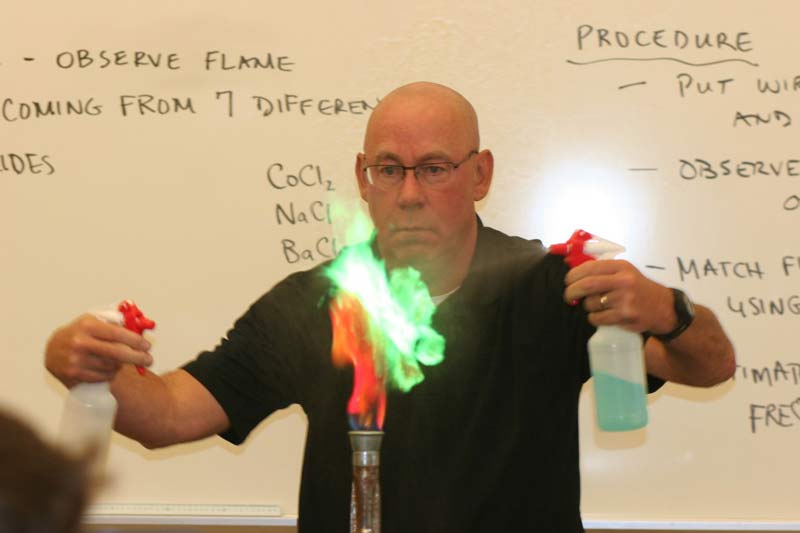
I learned this demo from a chemist named Walter White. Seriously. Episode #1. And yes, I enjoy teaching my students the “Heisenberg Uncertainty Principle”.
My resume is not meant to impress. Instead, my background indicates the opposite. I am not an expert. I make $40,000 less than my 15 year-old students will make as 24 year-old pharmacists. I’m proud to say I don’t have a Master’s Degree or a PhD. As my college chemistry teacher, Dr. Leland Harris, used to say, “Everyone knows what B.S. stands for. M.S stands for ‘more of the same’. PhD stands for ‘piled higher and deeper'”.
My only claim to fame is that I’ve worked 34 years in the educational trenches. Teachers are treated like privates in the bureaucratic army of education. A veteran teacher has the status of an entry-level worker at Walmart. Reforms are top-down. When my career started, schools were run “collectively”. Now teachers do what they are told and keep their opinions to themselves. Our pay is determined by the public’s interest in paying higher property taxes. Tenure and teacher pensions are under attack from both Republicans and Democrats. Our ivory-tower generals put more on our plate every year as public education attempts to reinvent the wheel at the expense of kids. Sorry for the rant, but background gives color to my writing.
Once a month, teachers at Plainfield North are required to attend a one-hour “professional growth” session after school. We meet as departments and usually waste our time discussing a book written by some former-teacher turned author.
This year, my science department is trying something new. We are doing teacher-led professional development. For the first meeting of the year, I was asked to present. I decided to present something out-of-the-box. Imagine teaching “The Simplified Science of Sprint Training” to a group of 15 high school science teachers at the end of a long school day. I call myself a “professional simplifier” but this assignment made me nervous. Of the 15 science teachers, only three were coaches. The others might be casual fans of the Cubs, Sox, Blackhawks, Bulls, and/or Bears, but not much more. None of the teachers in my audience had ever worn spikes (and if you ain’t wearing spikes, you ain’t sprinting) . My audience was a middle-aged mix of science nerds. Adapting my clinic presentation to this group was going to be a challenge.
If you can’t explain it to a six-year-old, you don’t understand it yourself. — Albert Einstein
I’ve been to track clinics where my brain rebelled and disengaged because the material was a convoluted labyrinth of unknown vocabulary and bewildering graphs. Science is complicated. My goal is to teach science to coaches and teach sprint training to science teachers.
Simplicity is the ultimate sophistication. — Leonardo DaVinci
Biochemistry of Sprinting
Let’s get real simple about sprint training. Sprinting involves the anaerobic energy system. Before I lose the football coaches here … anaerobic means “without oxygen”.
The entire day of the average adult is spent aerobically, or “with oxygen”. We walk, we sit, we eat, and we sleep. Some of us ride bikes. I am a runner. Being a “runner” at age 55 is code for being a jogger. Despite the fact that I’ve run four marathons, I do nothing anaerobically with the possible exception of weight training. People my age usually weight train without intensity, so I’m pretty much 100% aerobic these days.
The average adult is a terribly trained sprinter. Maybe we should consider the great lyric from Tom Petty’s “Last Dance With Mary Jane” … “Never slow down, never grow old”. In the real world, people age and slow down. We are only fast when we drive our cars.
Sprint training is simple. Run fast to get fast. Train with intensity for short duration. You don’t get fast by running slow. Never run slow. Train anaerobically. Rest and recover long enough to run fast. Never run tired. Never sprint train when your body is incapable of top-speed running. When you finish your short workout, eat well and take a nap. Rest and recover the next day, then repeat.
So why is there a dichotomy between sprint training and distance training? Simple. It’s due to energy systems, anaerobic vs. aerobic. Let’s investigate further.
People eat food. Food has chemical energy locked into the bonds of proteins, fats, and carbohydrates. All food can eventually be broken down into GLUCOSE. It is glucose that enters our cells. Whether you eat a candy bar or a ham sandwich, the fuel that enters your cells is glucose.
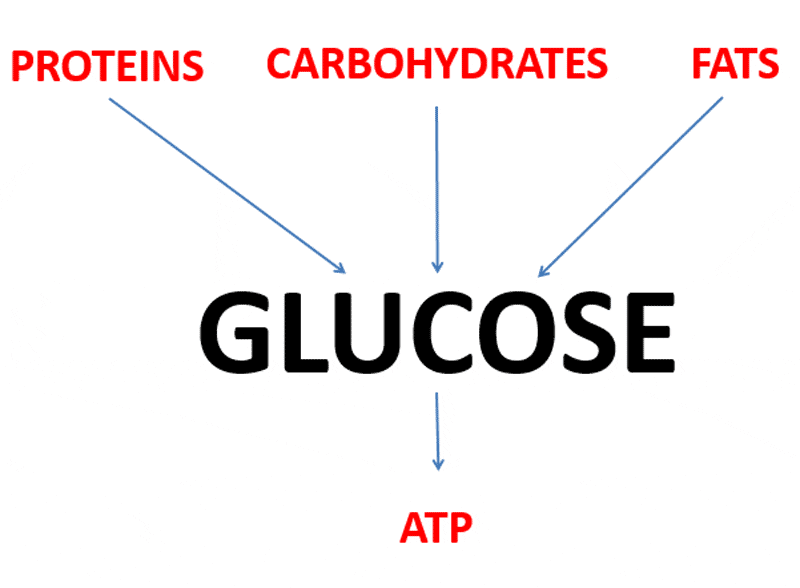
Inside the cells and only inside the cells, glucose is broken down further to create ATP. ATP stands for Adenosine Triphosphate. Don’t stop reading. ATP is the energy compound that fuels everything. Our body is fueled at all times by ATP. ATP is the fuel of sleeping, sitting, thinking, jogging, sprinting, etc. ATP comes from glucose and glucose comes from food. By the way, plants make glucose for animals by converting sunlight into chemical energy. The god of the sun was worshiped by the Egyptians (Ra), Greeks (Helios), and Romans (Apollo).
The first step in the transformation of glucose to ATP is called glycolysis. “Glyco” means sugar and “Lysis” means split. Yep, the 6-carbon glucose molecule is split into two 3-carbon pyruvic acid molecules. The benefit of this action is the production of two net ATP without the use of oxygen. ATP production without oxygen is anaerobic respiration. Sprinters listen up … this is your energy system!
Obviously, there is lots of chemical energy left to be harvested from the two 3-carbon pyruvic acid molecules but that will require a steady uninterrupted flow of oxygen, something sprinters won’t have. For those of you wanting to know more about this aerobic phase, here goes … the pyruvic acid molecules enter the mitochondria and goes through the Krebs Cycle, also known as the Citric Acid Cycle, the Tricarboxylic Acid Cycle, the Melvin-Calvin Cycle, or the TCA Cycle. Sprint coaches, ignore all of this. Yes, aerobic respiration efficiently provides us with energy to live our lives but does not fuel sprinters. Aerobic respiration allows people to run marathons but has nothing to do with running 200 meters in 20 seconds.

In review, anaerobic respiration happens inside the cell but outside the mitochondria. Anaerobic respiration creates 2 ATP from one glucose molecule but requires no oxygen. Aerobic respiration creates 36 ATP from the two pyruvic acid molecules but requires lots of oxygen. Both types of respiration creates ATP. Sprinters don’t have the oxygen needed to create boatloads of ATP, so glycolysis must be the focus. Don’t get confused by terminology.
Energy Systems
- Phosphogen System or ATP-PC System. This is simply getting energy from ATP. I call this training the PHOSPHATE ZONE (anaerobic).
- Gycolytic System. This is the splitting of glucose outside of the mitochondria to make ATP. Lactate is the eventual byproduct of glycolysis. I call this training the LACTATE ZONE (anaerobic).
- Oxidative System. This is the harvesting of ATP from pyruvic acid inside the mitochondria (Krebs Cycle). Sprinters should never be trained long and slow (aerobic).

I still don’t understand this crap. Biology teachers pretend to know it but they don’t. Just because you memorize something doesn’t mean you understand it. Here is the good news … sprint coaches can ignore the Citric Acid Cycle, and everything else that goes on inside the mitochondria.
Training Based on Energy Systems
Here is the good news … sprint coaches can ignore the Citric Acid Cycle, and everything else that goes on inside the mitochondria.
At the risk of over-simplification, you must train the correct energy system. If you are a marathon runner, train aerobically. If you are a sprinter, train anaerobically.
You have some ATP in your muscles ready for action at any given moment. When all-out intense effort is required (like sprinting), these ATPs provide the first five to ten seconds of energy. After that first five to ten seconds, ATPs from glycolysis provide energy for up to 90 seconds. Remember, glycolysis is the splitting of glucose without oxygen. Adults who sit, walk, and sleep will not have high-powered anaerobic engines. Pigs will fly before untrained adults are capable of sprinting 60 seconds. People who live their entire lives in the “aerobic zone” will run pathetic 400 meter times.
So how exactly do you train a sprinter? First of all, my sprinters run the 100, 200, and 400. Some obviously are more successful in the 400, some more successful in the short sprints. However, they are all in the same training group. 400 meter runners are not “middle distance” runners. I’ve often had the same 4-man relay team run my 4×1, 4×2, and 4×4. My sprinters train in what I call the “phosphate zone” most of the time. The phosphate zone is 100% effort for a period of 4 or 5 seconds followed by a 20 second rest. Sounds like football, doesn’t it? Our sprint drills take about five seconds each. Our workouts are so short that I encourage a “caffeinated” approach at every practice. With or without caffeine (I like caffeine and it’s legal), I want my sprinters to look and act like they’ve just had a venti Sumatra with a shot of espresso.
In a typical week of off-season sprint training, we will stay in the phosphate zone every day. I believe three days a week is enough. Monday, Wednesday, and Friday works perfect. Tues and Thursday gives time for rest and recovery. Saturday and Sunday gives time for rest, recovery, and growth.
Even though the focus of this section is anaerobic training, remember this type of sprint training is heavy on technique. In addition, caffeinated training teaches the nervous system to fire quickly. Sprinting is more electrical than it is muscular. Ever notice how strength is a very poor indicator of speed? Guys that squat 200 pounds can out-sprint guys that squat 400. High school freshmen who run 4.60 in the 40 are typically foreigners to weight training. You don’t get fast in the weight room. Run fast to get fast.
Let’s get back to energy systems. During the track season, we train the “lactate system” once or twice per week, never more. Lactate system? What the hell is that?
My high school coach back in the 1970’s used the term “lactic acid” all the time. I think all track coaches talk about lactic acid. If you ask them what it is, they can usually give you a short answer … “Lactic acid is the waste product of anaerobic respiration. This is what creates the ‘burn’ in your muscles and makes you sore the next day.” This is not far from the truth except for the “sore the next day” part. Soreness comes from lengthening a contracted muscle (eccentric contraction), not lactic acid.
The true chemistry involved in lactate training goes back to those two 2-carbon pyruvic acid molecules. Pyruvic acid, during prolonged intense effort, is converted to its conjugate base pyruvate which is converted to lactic acid which is converted to its conjugate base, lactate. Lactic acid is not measurable, lactate is.
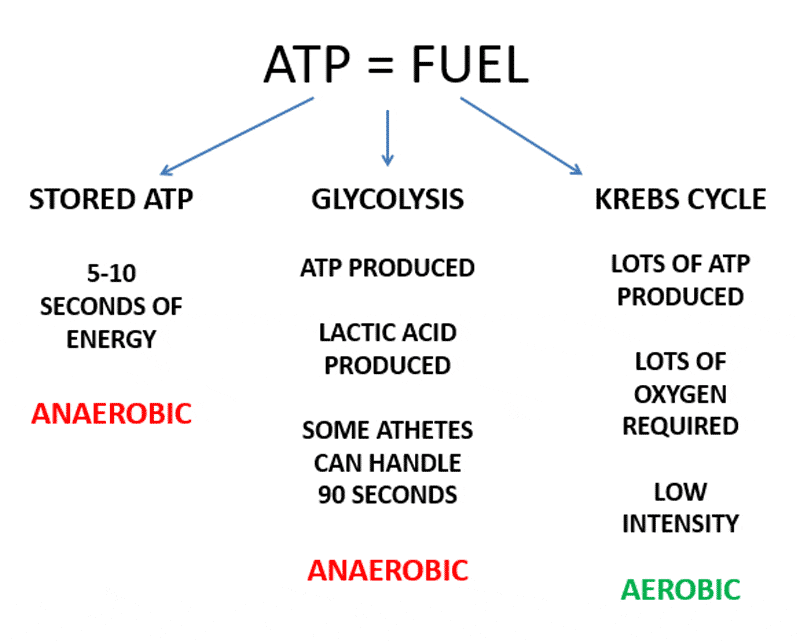
Lactic acid is short-lived. It quickly loses its hydrogen ion and becomes lactate. The hydrogen ion is responsible for the nasty side-effects of anaerobic training. For those of you who have forgotten all chemistry, acids increase the hydrogen ion concentration of water. This conversion of lactic acid to lactate results in a lowered pH, sometimes called acidosis. Acidosis will shut down glycolysis. Glycolysis can’t go on forever. I’ve read that 90-seconds is the upper limit. Aerobic respiration is infinite but the door to glycolysis will slam shut. No one sprints the 1600. Acidosis will cause blurred vision, dizziness, and nausea. Many runners lose their lunch when doing lactate training. Puking is a response to acidosis. Purging hydrochloric acid will help restore homeostasis.
Sorry for throwing these complex terms at you. Let’s simplify. Pyruvic acid, pyruvate, lactic acid, and lactate are all such similar terms that we can lump them all together and start calling them simply lactate.
Lactate is found in the blood when sprinters are at pushing their limits. Amazingly, marathon runners exhibit near resting-levels of lactate despite their exhaustion. Distance running uses a different energy system. Coaches don’t do blood tests on athletes to check them for blood lactate levels. Even though I can’t measure blood lactate it’s not hard to spot … dizziness, glassy eyes, and nausea. Like Supreme Court Justice Potter Stewart said about pornography, “I know it when I see it.”
Here is a story about lactate fitness vs. aerobic fitness. I went to Oswego High School with a guy named Dave Finnestad. Finnestad was a distance runner and a star basketball player. Finnestad was 6’4″ and once scored 49 points in a 32-minute high school basketball game. He later went on to win the NAIA National Championship in the 5000 (1981) and still holds the 10,000 record at Malone University (29:05.74). In the 1975 IHSA State Cross Country Championship, he placed 4th with a time of 14:24. Two days later Finnestad was the only guy throwing up after doing “suicides” and “killers” at the end of basketball practice. You see, Finnestad had incredible aerobic fitness but the rest of us had been trained in the lactate-zone. Dave Finnestad was well-trained for 14-minute runs, poorly trained for 30-second sprints.
Two important things happen when sprinters are trained in the “lactate-zone”.
- Training increases the rate of lactate clearance. The body is a smart machine that adapts to almost everything. Maybe you remember doing biology vocabulary work and looking up “homeostasis” in the glossary. Homeostasis is the body’s ability to keep internal conditions stable and relatively constant. If lactate levels are high, the liver converts lactate into glucose. The more this happens, the more efficient the conversion becomes.
- Training increases lactate tolerance. Trained athletes continue to perform at intense levels in spite of high amounts of lactate. Consider this “biochemical toughness”. The football coaches in the crowd will like this concept (if they are still reading).
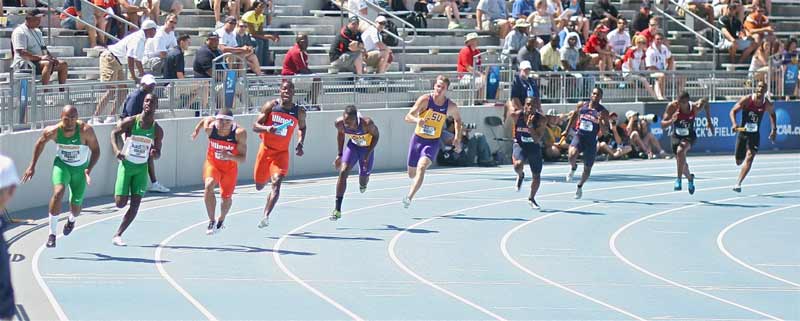
I had a good seat at the 2012 NCAA Championships. If you think these 4×1 teams got fast by doing long tedious aerobic workouts, you are probably a distance coach. Andrew Riley ran lead-off for Illinois after running a 10.03 in the 100 prelims the day before. He later won the NCAA 100 and 110 Hurdles. Wow.
So, how do we train the lactate system? It should be obvious. Sprint more than five to ten seconds. Most coaches make the mistake of over-training their sprinters. When you require a fast kid to run 5 x 300, they will run each one at 45-50 seconds. A 45-second 300 is good training for a 2:00 800-runner, horrible for a sprinter. The ground contact time will be long and their stride will change, creating bad habits. Here is a list of lactate workouts done at Plainfield North High School.
- 23-Second drill … sprinters run solo for 23 seconds at full speed trying to go as far as possible. Chalk marks on the track will indicate the distance they achieve. My best sprinters will typically run 200-210 meters. Eight minutes later, they run 23-seconds one more time. The goal is to come within 5 meters of their first mark. I record, rank, and publish their numbers. This drill must be done in a high-spirited electric atmosphere.
- Fly-500 … sprinters will run 5 x 100 with the wind (we like to do this drill on windy days). The sprints start on the fly (run-in start). Sprinters walk back to the starting line taking no more than two minutes. Every time is recorded. The five times are averaged, ranked, and published. This drill teaches sprinters to run fast but efficiently. You could almost consider this a lactate-threshold drill for sprinters. After the first 100, sprinters are dealing with lactate issues. This year we will use Freelap technology to get automated times for each guy.
- 4×4 Predictor … sprinters will run 3 x 200 with fly starts and with the wind. Sprinters will walk across the football field diagonally to begin the next 200. The rest will by only 3 minutes. This year we will use Freelap technology to record times. The times are added together then multiplied by .67. I then add 2.0 seconds to the product. These calculated times are recorded, ranked, and published. The times will accurately reflect the 4×4 speed of each sprinter. Once again, lactate levels get relatively high and sprinters must run fast regardless. This drill also teaches the idea of long sprinting. My cues are always “fast & loose” or “make it look easy”.
Timing systems are critical to sprint training. In the past, I’ve used the Summit System but it was wired and bulky. Summit could not be used in high winds or rainy conditions. I was basically limited to indoor use or outside on perfect days. In addition, I was limited to timing short distances like 30-meter starts and 10-meter flys. My new Freelap system will be used almost every day. “What you measure, you improve.”

I started with the Sprint-1 Coach for $750. I’ve since purchased three more watches ($249 each). I hope to have eight watches by the time my winter training (phosphate-zone) begins.
Coaches need to understand, track meets are lactate workouts. I want my sprinters to run 2 or 3 races at every meet. I want my sprinters to either run the 400 or the 4×4 at every meet. A perfect workout would consist of running all three sprint relays, the 4×1, 4×2,and 4×4. Running the 4×1, 400, and 200 is another perfect workout.
My off-season sprint training is 100% phosphate-zone. In-season training is about 60% phosphate-zone, 40% lactate-zone. Here is a typical week in April.
- Monday: Triangular Meet … lactate
- Tuesday: Sprint Holiday … rest
- Wednesday: Speed drills and strength work … phosphate
- Thursday: Speed drills and block starts … phosphate
- Friday: Speed drills and handoffs … phosphate
- Saturday: Invitational … lactate
Notice in the week above, both workouts were actual meets. Wednesday, Thursday, and Friday would be short practices. Less than 40 minutes. If we only had one meet, we would do a lactate workout in practice. Why not three lactate-zone workouts per week? Three hard workouts in a week will lead to diminishing returns. Sprinters get injured. Sprinters get depressed. Happy and healthy sprinters maintain a “bounce” through the season. The combination of rest, sleep, hydration, and nutrition is more important to a sprinter than any workout. Coaches flatter themselves by thinking they create a sprinter. At every clinic, coaches are searching for magic workouts. Great sprinters are found (or recruited) and then nourished and maintained. The cumulative effect of two lactate workouts every week for 10-20 weeks will result in sprinters learning to sprint 400 meters … or run multiple races at top speed. Banged-up depressed sprinters are never successful. Less is more. Don’t train hard, train smart.

Lactate workouts are hard. Pictured is Annile Williams who was an all-state hurdler last year in his junior season. Annile ran 14.55 in the 110 Highs and 38.90 in the 300 Intermediates. Eventually sprinters get better at lactate CLEARANCE and lactate TOLERANCE. You can’t achieve this if you stubbornly stick to high volume workouts.
When I present my ideas at track & field clinics, the first question is always the same. “But what about the 400?” People who ask that question fail to understand that quarter-milers are sprinters and vice versa. I train all my sprinters the same. I’ve been a head track for 25 years. My 4×4 teams have won state medals 15 times. You can ignore aerobic training and win the 4×4. Our sport is inundated with distance coaches having aerobic mindsets. Repeat after me … Cats don’t jog … Cats don’t jog … Cats don’t jog.
“Don’t forget that the most important problem to solve is to make easy what is difficult, and for this goal we need to be very simple in our approach, bringing our athletes to train more without too much pressure from hard workouts.” – Renato Canova
So, when do sprinters do aerobic training? Never. Sprinters, like all of us, live aerobic lives. There is no need to jog. Slow running is counter-productive. Enjoy aerobic activities but sprint training must be short, caffeinated, and intense.
Anatomy & Physiology of Muscle Fibers
Let’s get away from the biochemistry of cell respiration. Let’s talk muscle.
Most coaches have heard of fast-twitch and slow-twitch muscle fibers. Fast guys have a high percentage of fast-twitch fibers. Great jumpers are also predominately fast-twitch. Slower guys have a high percentage of slow-twitch fibers that are better for endurance and strength over longer periods of time.
Fast-twitch fibers are white due to less blood flow. Why do they have less blood flow? Because they are anaerobic in nature. Fast-twitch fibers have fewer mitochondria. Why is the worth mentioning? Fast twitch fibers are the muscle fibers of sprinting, therefore less blood-flow, less oxygen, and fewer mitochondria are needed.

On the other hand, slow-twitch muscle fibers are red. Slow-twitch muscle fibers are red due to blood flow. Lots of capillaries bring oxygen to mitochondria to harvest ATP through aerobic respiration. Slow-twitch fibers are aerobic. Long sustained effort is accomplished by the work of red slow-twitch fibers.
What does all of this mean for sprint coaching? First, find fast-twitch athletes and build your track team around those guys. How do you find these fast-twitch freaks? Identify the boys in your school who can dunk a basketball. Develop relationships with the running backs, receivers, and defensive backs on your school’s football team. Create an atmosphere where kids want to be timed in the 40-yard dash and the 10-meter fly. Use Freelap to time kids, then record, rank, and publish. Promote excellence. Celebrate improvement.
Here is an interesting question: If your muscle composition is predominantly slow-twitch, are you doomed to a lifetime of distance training? The answer is yes and no. Fast-twitch athletes are born with an advantage. If you look at the elite sprinters, none of them started as slow white guys. In my experience, 90% of all elite sprinters were very fast by the time they were 15 years-old. Training did not create their speed. However, some muscle fibers are “in-betweeners”, with the ability to evolve into fast-twitch or slow-twitch based on training. I have read where 40% of muscle fibers are transitional. So how do you push those transitional fibers toward fast-twitch? You sprint and jump. You jump and sprint. You train with short duration and high intensity. You don’t run mileage. Your training does not include four-hour bike rides. You don’t swim countless laps. “You don’t plant beans and grow corn.” Do I need to say more?
Physics of Sprinting: Overcoming Gravity
Sir Isaac Newton stated that “Any two bodies in the universe attract each other with a force that is directly proportional to their masses and inversely proportional to the square of the distance between them.” Since the earth is quite large and we are quite close, gravity plays a monumental role in our lives.

No calculations are necessary to understand gravity’s relationship to sprinting. However, you must understand that gravity is a huge force compared to the horizontal forces encountered by a sprinter. Horizontal forces include wind resistance (drag) and friction.
I once heard a track coach instructing a young sprinter to “grab the track and throw it behind you”. This would indicate that horizontal forces are the biggest concern of a sprinter. This is wrong. Totally wrong. This biggest concern is gravity and that must be the focus of proper running mechanics. Note, I am talking about sprinting here, not drive-phase acceleration.
Elite sprinters have minimal ground contact. In a way, they fly. To create minimal ground contact sprinters lift their foot in front of their hips and then hit the track hard. Good sprinters hit the ground with so much force that the foot bounces off the track. Ground contact times of world record holders have been measured at .080 seconds. Sprint spikes have no cushion. Cushion makes for a soft-landing and longer ground contact times.
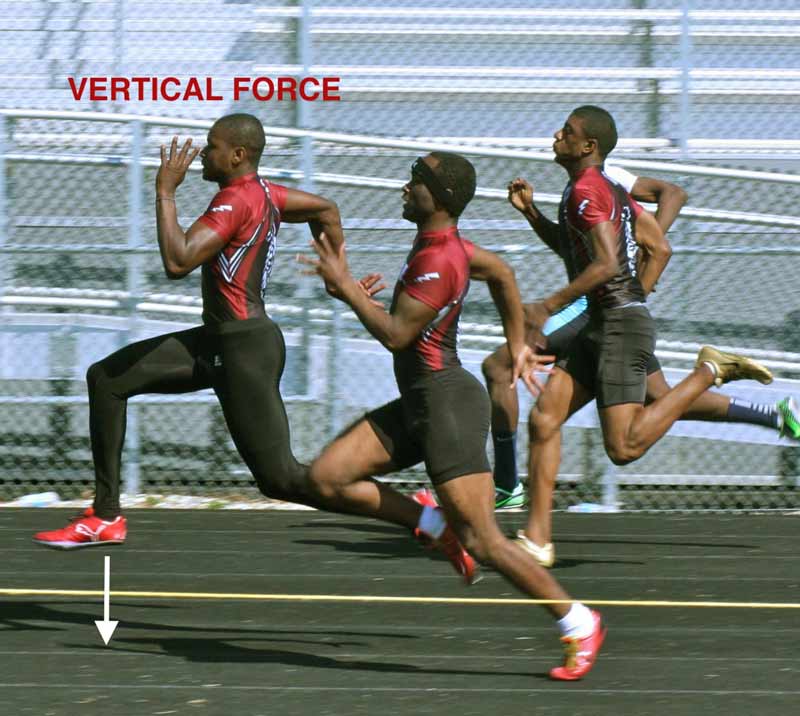
These three guys allowed Plainfield North to medal in the 4×1, 4×2, and 4×4 in 2011. The lead runner, Quest Young, was a 48-second quarter-miler with great mechanics (with the exception of a floppy back-hand). His posture was terrific. Note how tall he runs. The tallness allows for great knee-lift. I love his dorsi-flexed foot. His mechanics allowed him to “hammer down” exerting lots of vertical force. By the way, the “hammer back” action of the arm adds to the vertical force of the foot strike. The other two guys, Marquis Flowers and Randy Gordon were also very good.
How do you teach minimal ground contact? Basically you do drills of short duration and high intensity where you bounce off of the track. Drills where you land and jump at the same time are called plyometrics. Like all speed training, plyometrics must be caffeinated. Like all speed training, plyometrics must be limited because they are very intense. I love bouncy sprinters.
Gravity is the reason that coaches should never encourage a sprinter to gain 20 pounds. Gravity makes big people slow, unless they can proportionally increase their ability to exert force into the ground. It’s easy to gain weight, hard to improve explosive force. When I see football players getting thick through the chest, back , and arms, I immediately think uh-oh, weight gain = speed loss. Natural weight gain through puberty, growth, and well-designed strength training is fine. Artificial weight gain (eating entire jars of peanut butter, etc.) will slow you down.
I believe in strength training but not body-building. I believe in lifting in ways that translate to speed. Before blindly adopting a weight training program, ask yourself, “Are elite sprinters great at these lifts?”. Do deep squats improve speed? Does the bench press improve speed? Do pull-ups improve speed? Do power cleans improve speed? In my experience, sprint training often counter-balances the negative effects of weight lifting. I’ve seen no evidence that proves the correlation between weight lifting and speed gain. Boo Schexnayder’s strength training program is probably terrific. Arnold Schwarzenegger’s body-building programs of the 1970’s would ruin a sprinter. Sad to say, most high school football coaches are more like Arnold and less like Boo.
In last spring’s NFL Combine, only ten guys ran times less than 4.40. The average height and weight of those ten players was 5’10” and 188 pounds. Weight training and weight gain in the absence of speed training is delusional Neanderthal thinking. Greyhounds are faster than Mastiffs.
Specificiy & Simplicity
You can skip Biology, Chemistry, Anatomy, and Physics if you understand the “Principle of Specificity”. Training should be relevant and appropriate to the sport for which the individual is training in order to produce a training effect. “You don’t plant beans and grow corn.” If you are a swimmer, swim. If you are a cyclist, cycle. If you are a sprinter, sprint.
Coaches waste time when they believe weight lifting creates fast runners. Coaches waste their time when they believe that long monotonous aerobic sessions will benefit their sprint relays. Coaches waste time when they put their sprinters through Navy Seal training thinking toughness creates champions.
In addition to specificity, think simplicity. I train sprinters at max speed for about five seconds at a time. Max speed is damn important. During the season we do two lactate workouts per week. Simple.
Fill in your practice time with blocks starts, accelerations, hand-offs, hurdles, and field events. Trust the fact that sprinting is anaerobic. Keep distance coaches away from your sprinters. Do your best to influence transitional muscle fibers to become fast-twitch. Make vertical force the holy grail when you teach sprint mechanics. Teach sprint mechanics daily. Understand that over-trained, banged-up, depressed sprinters will never rise to the occasion. Keep it specific, keep it simple, and above all, keep it fun.
The simplified science found in my presentation are the facts as I know them. Many coaches get lost in the science and resort to the lowest common denominator … coaching the way they were coached. Connecting science to sprint training makes sense to me.
Please share this article so others may benefit.
[mashshare]


Best blog yet coach!
Good work, Tony!
The issue of “energy in” or “force out” relative to sprinters will remain a problem for coaches because of some long held, common assumptions which Dr. Weyand addressed here in Lisle back in August. What are these assumptions?
1) Energy limits all-out performance
2) Increasing energy supply will improve performance
3) Decreasing energy demand will improve performance
4) Training should thus target both energy supply and demand.
Though valid for distance running, it is not valid for sprinting.
Thank you for sharing. As a new coach I am very interested in learning all I can to help my athletes succeed this season
I really believe in your concepts.
How can I convince my high school coach to consider your concepts?
My son is now a sophomore and last year as a freshman they destroyed his legs with pulled hamstring and terrible shin splints. both of which he hadn’t experienced before.
as an eight grader he did the following
long jumped 19-8″
100 m 11.3
as a sophomore
long jump 16-5″
100 m 11.4, 11.8, 12.2
ended his running and jumping after three meets
changed due to my insistence at no longer trying to train sprints
did high jump and javelin and pole vault instead to try and salvage the season
6-0, 189-10′ and 12’6″ with little to no training in any of them. just natural ability and having fun
your comments would be greatly appreciated
We are Maryna van Niekerk and Owen van Niekerk from South Africa. Which you can come and visit us. We talk the same language when it comes to sprinting. We did years of research on this and totslly agree with your training methods. Speak again